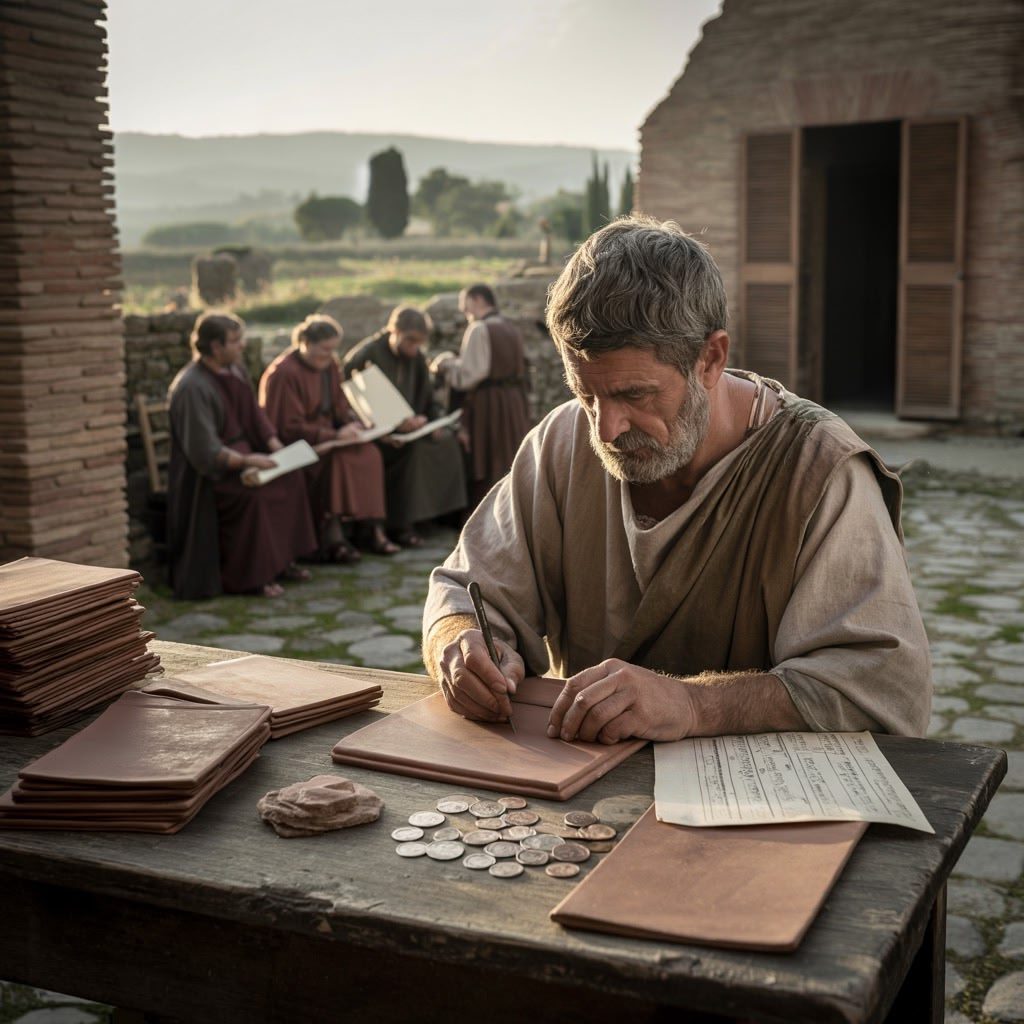How Ancient Romans Managed Personal Finance and Household Budgets explores the financial practices of this ancient civilization. Studying these historical methods provides valuable insights into the origins of modern financial management. By looking at how Ancient Romans handled personal finance and household budgets, we can find similarities with today’s practices, showcasing both the progress made and the timeless principles of financial management throughout history.
Pre-Banking Financial Practices
Ancient Romans managed personal finance largely through property wealth. Land ownership and real estate were central to one’s financial standing and ability to sustain household budgets. Wealth tied up in property served as both a source of income and collateral for financial dealings.
Loans among Roman elites functioned informally before formal banking institutions emerged. These loans were often based on social relationships rather than strict commercial terms. Trust and reputation played a critical role, with interest sometimes being secondary to maintaining alliances or fulfilling obligations within elite circles.
The formation of societates marked a significant step in financial coordination. These were partnerships or associations where multiple property owners pooled resources for common ventures, such as government contracts or large-scale commercial activities. Societates allowed participants to share risks and profits, providing a structured way to manage collective finances without relying on formal banks.
Key aspects of pre-banking finance included:
- Property wealth as the foundation for financial dealings
- Loans grounded in informal, trust-based agreements among elites
- Use of societates to coordinate shared investments and contracts
This system relied heavily on personal relationships and tangible assets, setting the stage for more complex financial mechanisms that developed later.

Emergence of Banks in Rome
The development of banks in Rome was heavily influenced by Greek banking practices, with the first appearance of banks around 310 BC. These banks operated under private law and were built on the reputation and trustworthiness of bankers. During this time, loans were primarily oral agreements between parties.
However, a significant transition occurred as written contracts known as chirographum became more prevalent for recording loan terms formally. This shift towards written agreements marked a crucial step in the evolution of banking practices in Rome, bringing more structure and legal clarity to financial transactions.
Record-keeping played a vital role in the functioning of these early banks. Bankers maintained detailed records using a system called kalendarium to track loans and interest owed by borrowers. This meticulous record-keeping not only facilitated transparency and accountability but also helped in managing the financial operations efficiently.
The emergence of formal banking institutions with written contracts and sophisticated record-keeping systems represented a significant advancement in financial management during ancient Roman times.
Evolution of Loan Practices
The Ancient Romans employed various strategies in managing their personal finances and household budgets, including the evolution of loan practices. Here are some key points to consider:
Use of Collateral for Securing Loans: Romans often used collateral, such as property or valuable assets, to secure loans. This practice provided a level of security for lenders and ensured that borrowers had a vested interest in repaying their debts.
Common Practice of Deferred Payments: In Roman financial transactions, it was common to defer payments for large purchases or agricultural products. This flexibility allowed individuals to manage their cash flow effectively and navigate seasonal fluctuations in income.
Role of Professional Bankers like the Sulpicii: Professional bankers, like the Sulpicii, played a crucial role in providing financing to individuals and businesses. These bankers facilitated transactions, offered financial advice, and helped stimulate economic activities within the community.
Through these practices, Ancient Romans demonstrated a sophisticated approach to managing loans and credit arrangements, laying the foundation for modern financial systems.

Fiscal Management at the State Level
Ancient Rome: The Senate’s Role
In Ancient Rome, the management of public finances was primarily in the hands of the Senate, which had significant power over the state’s treasury. This early system was based on conservative principles, aiming to maintain the financial stability of the Republic. However, there were frequent problems of mismanagement and inefficiency caused by political rivalries and a lack of centralized control. This resulted in inconsistent revenue collection and spending.
The Shift to Imperial Control
With the rise of the Roman Empire, there was a major change as emperors gradually took direct control over financial matters. This shift led to the establishment of a more advanced treasury system, which divided state revenues between two main funds:
- Aerarium: The traditional Senate-controlled treasury that managed public revenues during the Republic.
- Fiscus: The imperial treasury controlled by the emperor, responsible for funding military campaigns, administrative costs, and other imperial expenses.
This division allowed for a clearer distinction between senatorial finances and imperial resources. The emperor’s authority over the fiscus enabled more efficient taxation and better supervision of expenditures throughout the vast empire.
Specialized Officials and Accountability
As part of this dual treasury system, specialized officials emerged with specific roles:
- Overseeing revenue collection
- Managing public spending
- Ensuring accountability
These officials played a crucial role in maintaining order and transparency within both the Aerarium and Fiscus.
A Shift in Governance
The transition from Senate dominance to imperial administration reflects a broader trend in Roman governance—moving from decentralized fiscal management toward centralized authority. This shift aimed to enhance efficiency in handling the complex financial needs of the empire.

Personal Financial Management Strategies
The ancient Romans believed that managing personal property was the key to building wealth. They understood that their household assets, such as land, slaves, and goods, needed careful attention in order to preserve and increase their family fortunes. For them, property was not just something they owned; it was also a source of income and social status, requiring thoughtful distribution and protection.
The Role of Social Networks in Credit Arrangements
In the Roman society, credit arrangements were heavily reliant on social networks. This meant that lending and borrowing activities among family members, friends, and business partners often depended on mutual trust instead of formal contracts. These informal systems of credit allowed for flexibility in managing cash flow without the need for immediate cash transactions. It was common for social obligations to play a significant role in these agreements, making one’s reputation crucial when it came to accessing credit.
The Importance of Record-Keeping Practices
To maintain transparency over debts and payments, the Romans recognized the importance of keeping accurate records. Whenever possible, they would use written documents like the chirographum to formalize agreements. However, on a day-to-day basis, accounting relied heavily on ledgers and notes maintained by household stewards or private accountants. By diligently logging transactions, they ensured accountability and minimized conflicts within their extended financial relationships.
Key Strategies for Personal Financial Management
Here are some key strategies derived from the financial practices of ancient Romans:
- Conducting thorough inventory assessments of your assets to gain insights into your overall wealth
- Leveraging personal connections and networks to secure short-term loans or lines of credit when needed
- Implementing effective record-keeping systems to accurately track outstanding debts and repayment schedules
These strategies combine practical management techniques for property with social mechanisms for finance, creating a robust system that strikes a balance between trust-based interactions and documentation-based processes.

Collective Financial Ventures and Imperial Oversight in Ancient Rome
In Ancient Rome, individuals often engaged in collective financial ventures through societates, which were groups formed to pool resources for various financial endeavors. These societates allowed Romans to combine their assets and participate in larger projects or investments that would have been challenging to undertake individually.
Moreover, these collective financial activities existed within a framework of centralized imperial oversight. While private financial practices were common among Romans, especially within their social networks, there was also a significant level of control exercised by the imperial authorities. This combination of private initiatives and imperial supervision ensured a balance between individual wealth management and broader fiscal regulations.
Societates participation enabled Romans to tackle ambitious projects beyond their individual capacities, fostering cooperation and shared financial interests within the community. At the same time, the presence of centralized imperial oversight provided a level of stability and regulation to ensure that financial activities align with the broader economic goals of the empire.
This dual structure of collective financial ventures through societates and centralized imperial oversight highlights the intricate balance between private initiative and governmental control in managing personal finances and household budgets in Ancient Rome.
Legacy of Ancient Roman Financial Practices in Modern Times
The financial practices of Ancient Rome have had a lasting impact on the world, influencing modern financial systems across the globe. Here are some key aspects of their legacy that can be seen in today’s financial practices:
- Influence on global financial systems: The principles and concepts developed by the Ancient Romans laid the foundation for many aspects of modern finance. From trade agreements to investment strategies, their ideas continue to shape economic systems worldwide.
- Collateral and credit arrangements in banking: Just like in Ancient Rome, contemporary banking practices often involve the use of collateral and credit arrangements. These mechanisms provide security for lenders and enable borrowers to access funds for various purposes.
- Record-keeping in accounting: The importance placed by the Romans on meticulous record-keeping for debts and payments is still relevant today. Accounting principles emphasize accurate documentation of financial transactions, ensuring transparency and accountability.
Understanding how the Ancient Romans managed their personal finances and household budgets can offer valuable lessons for us today. By studying their approaches to money management, we can gain insights into effective strategies that can be applied in our own lives.
Their legacy lives on through these practices that continue to influence the way we handle our finances.

